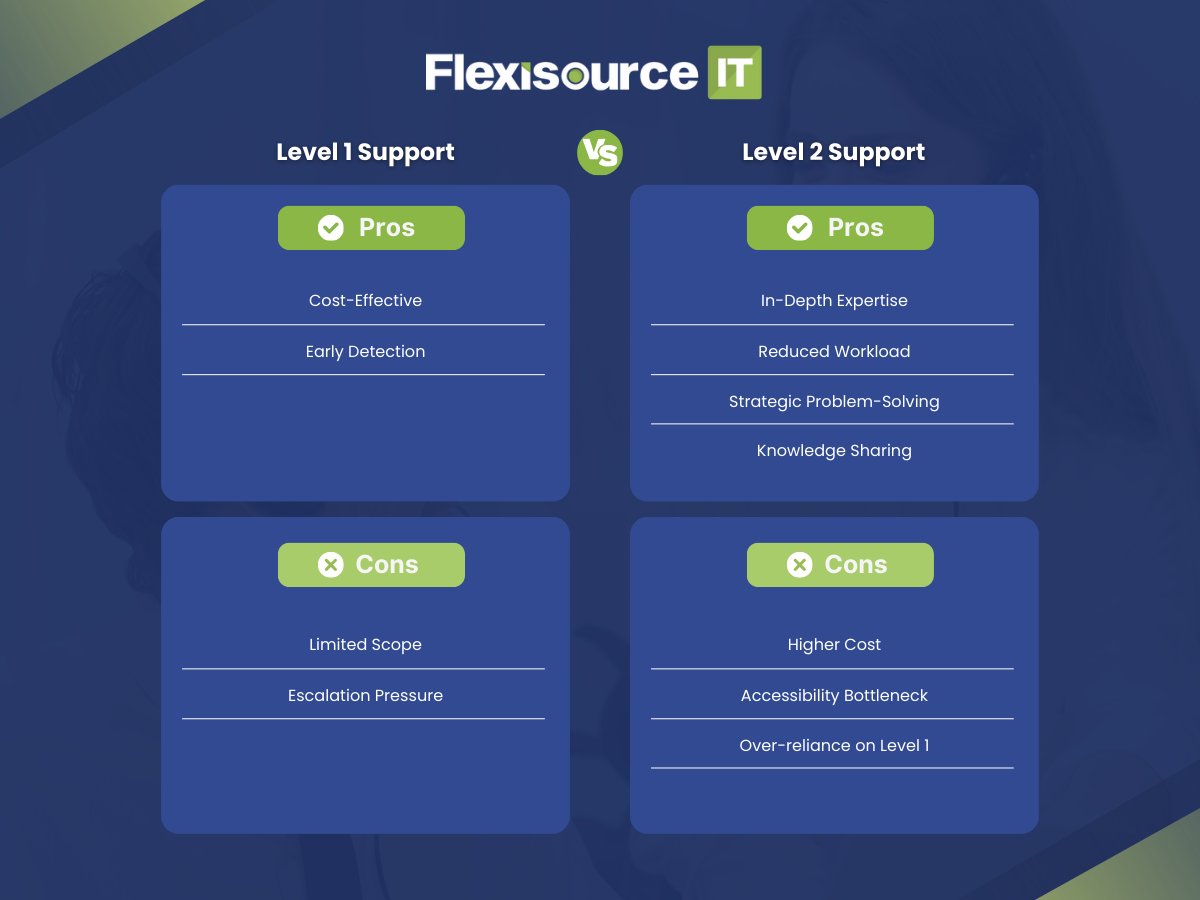ile, You may have experienced this before: You open a program on your computer and encounter an error message. You try to fix it yourself again, and again. However, you experience the same error.
In times like this, you have a go-to person to help you: IT Support.
For a business, providing top-notch support makes a world of difference when retaining customers. Most people are more likely to stay loyal to your brand when they know that you have great customer IT support.
However, the challenge is figuring out which technical support levels people will need.
Luckily, you are in the right place. Here, we are differentiating Level 1 vs Level 2 support to better serve your customers.
Understanding IT Support
Before we get to explaining the support tier differences, let us briefly touch on why is it important for your business.
What is IT Support?
At its most elementary level, it is about offering assistance to your staff for any technology-related issues, which can range from computer systems, networks, and software.
It also includes instances:
- Installing and configuring hardware and software
- Monitoring systems for security threats
- Resolving technical issues
Why do you need it?
There is a booming demand in Australia’s tech sector—you could even say it is on a roll. However, there is a growing gap in supply.
In fact, according to a 2021 ACS Australia’s Digital Pulse report by Deloitte, the annual demand generates 60,000 new jobs in the IT industry alone. Yet, only 6,500 IT graduates are entering the workforce.
To put that into perspective, tech sector vacancy rates are 60% higher than the national average. This talent gap is not just a statistic; it is a crisis that poses a threat to the very foundation of countless businesses.
With that in mind, outsourcing IT support in the Philippines may be more of a necessity than a luxury. Of course, this is not the only choice, but it is a great one if you value both cost-efficiency and high quality.
When considering tech support, you must understand the distinction between Level 1 vs Level 2 support. This tiered approach allows you to efficiently address a wide range of IT challenges and maintain optimal performance.
Aside from the talent gap, here are other aspects that underline why IT support is an important “cog” to keep your business running smoothly:
Cybersecurity Threats
Businesses online are prime targets for cyberattacks. Naturally, you need a robust IT support system as your first line of defence, constantly monitoring for threats and vulnerabilities.
Cloud Adoption
Cloud technology is revolutionising how businesses operate but it also presents new challenges. IT support specialists help ensure smooth cloud migrations, data security, and ongoing maintenance.
Remote Work Revolution
Hybrid and remote work setups are here to stay. Consequently, this demands reliable IT infrastructure and support to address a host of issues from video conferencing glitches to secure remote access.
Customer Experience
Excellent and consistent customer experience is crucial for business. As such, a responsive and efficient IT support system ensures minimal downtime, resolves customer issues quickly, and ultimately boosts customer satisfaction and loyalty.
Level 1 Support vs Level 2 Support
So, we have established the what and why. Now, let us break down the support tier differences.
With that said, these levels actually go up beyond Level 3 IT support. But, in this article, we are focusing on the difference between Level 1 support vs Level 2 support since these are the ones you will need the most.
What is Level 1 IT Support?
In the tech support hierarchy, Level 1 support is the frontliners. Think of these technical specialists as the friendly first responders of the IT world.
A lot of people approach them for a broad range of tech issues, big or small. In addition, they are the ones who answer your emails, calls, and even social media cries for help with a smile and a toolbox ready for action.
As the initial touchpoint of all the IT support levels, here is a list of what they do:
- Information Gathering – Specialists at this level gather information, dig into symptoms, and ask those key questions to understand the problem.
- Basic Troubleshooting – They follow tried-and-true procedures first to get things back on track.
- Technical Translation – Level 1 specialists are the ones who inform and explain every step of the process to the end-user or client in a way that is easy to understand.
- Escalation Expert – When things get trickier, they are the ones who record the case for a seamless pass of the baton to Level 2 specialists.
Advantages and Disadvantages of Level 1 IT Support
Pros
- Cost-Effective – It is the initial triage point, resolving simpler issues which saves time and resources for higher-level intervention.
- Early Detection – It acts as the early warning system, identifying potential issues before they snowball into bigger problems.
Cons
- Limited Scope – It has access to resources and tools that may be restricted, hindering troubleshooting for complex issues and leading to frustration.
- Escalation Pressure – It emphasises swift resolution which leads to missed opportunities for learning and potentially resolvable issues being escalated prematurely.
When to Use Level 1 IT Support
- Routine Glitches
- System Inquiries
- Initial Problem Identification
- Early Problem Spotting
With that said, you can save a lot of time deciding between Level 1 support vs Level 2 support when you have a predefined IT Support Levels guide.
What is Level 2 IT Support
If Level 1 support specialists are the frontliners, then Level 2 support specialists are detectives of the IT world. They are responsible for analysing complex problems. Usually, they are better equipped with advanced tools and possess a deeper understanding of systems and networks.
Here are their capabilities:
- Deep-Dive Diagnostics – Level 2 specialists wield potent analytical tools to dissect complex tech problems. They delve into system logs, network traces, and obscure error messages, to spot and resolve these issues.
- In-Depth Technical Knowledge – They possess a mastery of hardware, software, and network infrastructure to effectively navigate intricate technical landscapes.
- Problem-Solving Architects – Specialists of this level design sophisticated solutions, implement them with precision and ensure IT systems function well.
- Collaboration Champions – They work hand-in-hand with Level 1 technicians for a seamless collaboration to ensure a cohesive and efficient support ecosystem.
Advantages and Disadvantages of Level 2 IT Support
Pros
- In-Depth Expertise – It tackles complex problems with deeper analysis and more effective solutions.
- Reduced Workload – It handles intricate issues which frees up Level 1 to focus on routine tasks, improving overall efficiency.
- Strategic Problem-Solving – It delves into root causes, preventing recurring issues and implementing proactive measures for smoother system operation.
- Knowledge Sharing – It serves as a valuable resource for Level 1 training and knowledge transfer, leading to continuous improvement across the support ecosystem.
Cons
- Higher Cost – It requirements for higher level expertise and experience come at a higher price.
- Accessibility Bottleneck – It may involve longer wait times or stricter escalation criteria, potentially frustrating users seeking urgent assistance.
- Over-Reliance on Level 1 – This occurs if Level 1 is not properly equipped and empowered. As a result, there is increased dependence on Level 2 interventions.
When to Use Level 2 IT Support
- Systemwide Meltdowns or Outages
- Security Threats or Breaches
- Tech Problems Persist
Quick Review: The Difference Between Level 1 vs Level 2 IT Support

Before we end things, let us review the difference between these two IT support levels. Here is a condensed version of what we have shared:
Scope of Issues
Level 1: Handles basic, common issues
Meanwhile, Level 2: Deals with more complex and technical problems that Level 1 could not resolve.
Technical Expertise
Level 1: Requires strong customer service skills and basic technical knowledge.
On the contrary, Level 2: Possesses deeper technical expertise and understanding of IT systems.
Tools and Resources
Level 1: Uses common IT tools and basic diagnostic software.
Conversely, Level 2: Access to more advanced diagnostic tools, specialised software, and proprietary resources.
Escalation and Resolution Times
Level 1: Tries to resolve issues within a set timeframe.
On the other hand, Level 2: Takes longer to resolve complex issues due to in-depth analysis and the potential involvement of multiple parties.
Communication and Interaction
Level 1: Primarily interacts with users directly through phone, email, or chat platforms.
Meanwhile, Level 2: May interact with both users and Level 1 technicians to gather information and diagnose issues.
Conclusion
It is not Level 1 support vs Level 2 support, rather they are partners in arms. They play separate, yet equally vital, roles that ensure your business’s IT ecosystem runs smoothly.
If you think about it, they are analogous to characters in a crime show: Level 1 specialists are the first responders who analyse the crime scene and record everything. On the other hand, Level 2 specialists are the detectives who go back for a more in-depth look and piece together the clues to find the culprit and bring them to justice.
With the increasing demand for more highly skilled tech talents, it can be limiting for business if you only search within your country’s shores. Considering the talent gap and Australia’s highly competitive job market, exploring options such as outsourcing IT support in the Philippines becomes a strategic move that empowers your business to have a seamless operation and boost customer satisfaction.
Contact Flexisource IT for expert guidance on optimising your support structure. Our professionals can assist you whether you need Level 1 or Level 2 support.





